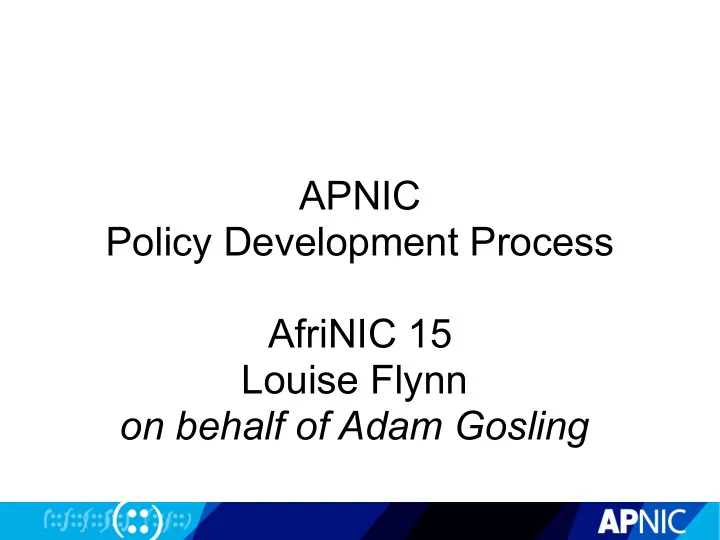

APNIC Policy Development Process AfriNIC 15 Louise Flynn on behalf of Adam Gosling
Policy SIG Charter • Develop policies and procedures which relate to the management and use of Internet address resources by APNIC, NIRs and ISPs within the Asia Pacific region • Mailing lists sig-policy@apnic.net sig-policy-chair@apnic.net
Policy Development Process Open • Anyone can propose policies • Anyone can discuss policy proposals Transparent • All discussions archived and available to public • Policy changes all documented and archived Bottom-up • The community drives policy development • The community decides policy outcomes
Policy Development is a Cycle 4
Policy Development Process
Steps to Implementation 1. Proposal submission 2. Mailing list discussion before meeting 3. Consensus at Policy SIG Meeting 4. Consensus at again at Member Meeting 5. Comment Period to confirm consensus 6. EC endorsement 7. Editorial Comment period 8. Implementation
Consensus Decision Making The consensus decision-making policy development process facilitates an open, bottom-up, and transparent policy process for all stakeholders Consensus is described as “general agreement” where the Chair “takes into consideration” comments on mailing list and at meeting Show of hands may be taken as a way of “broadly gauging opinion”. It is not a vote as this would disadvantage those not physically present If objections are raised, the chair will ask participants to work together to resolve these issues where possible.
Consensus Decision Making Used in the PDP to facilitate Open (multi-stakeholder involvement) Bottom-up (community-driven, not top-down) Transparent (public and documented)
Consensus Decision Making Consensus is described as “ general agreement ” Chair “ takes into consideration ” comments on mailing list and at meeting Show of hands is a way of “ broadly gauging opinion ” Voting would disadvantage those not physically present
Objections Minor Objections some problems may occur for some members of the group Major Objections major problems will occur for parts of the community Participants should “work together” to resolve
References • APNIC Policy Development Process www.apnic.net/policy/policy-development • SIG Guidelines www.apnic.net/sigs/sig-guidelines.pdf • Mailing list archive mailman.apnic.net/mailing-lists/sig-policy • Mailing list subscription mailman.apnic.net/mailman/listinfo/sig- policy
Recommend
More recommend